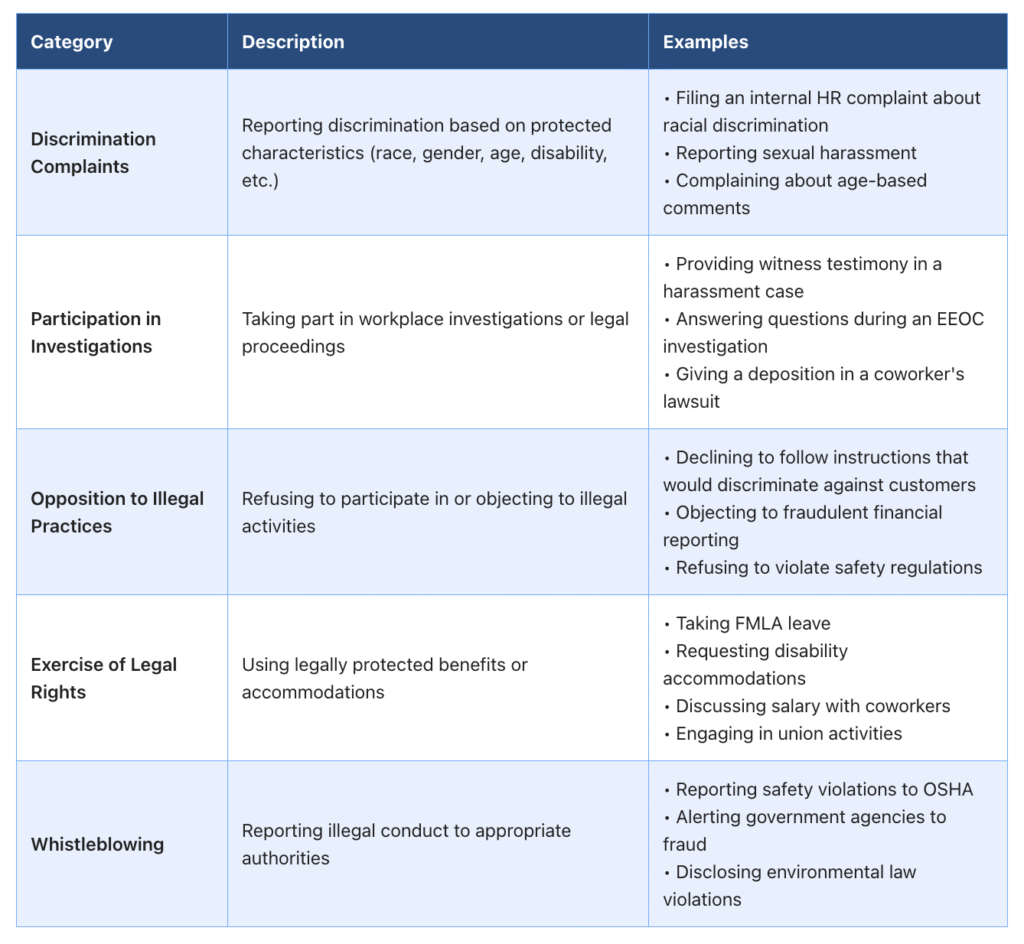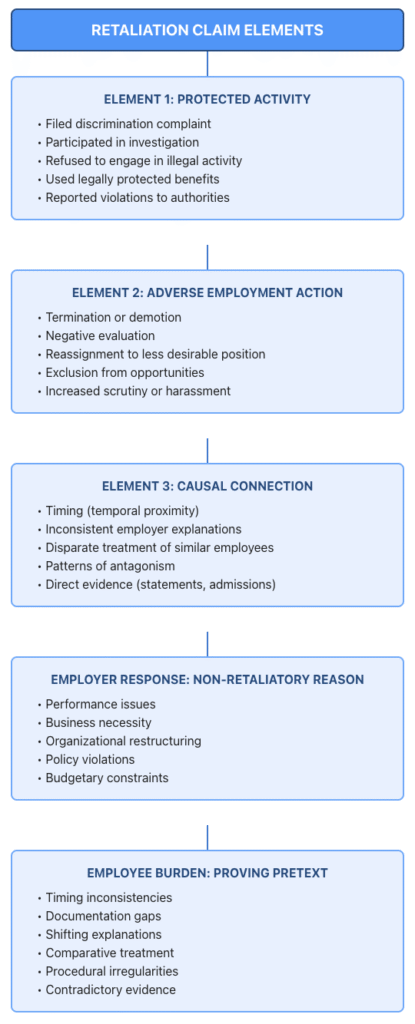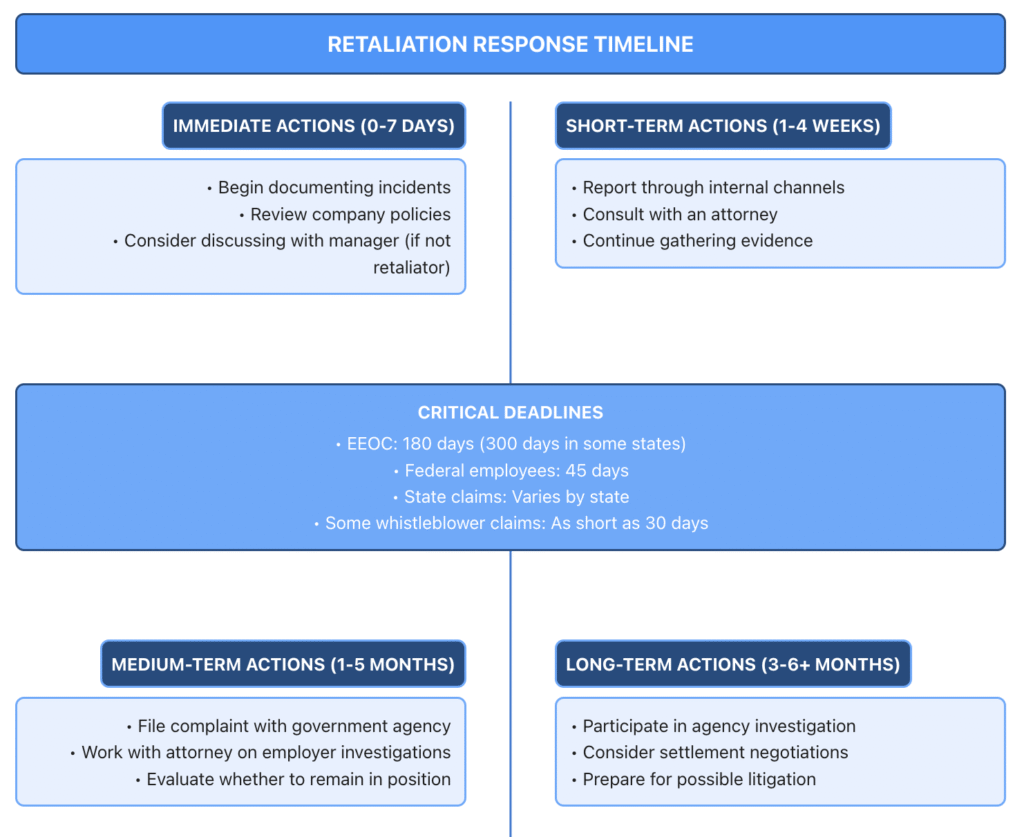Have you recently reported discrimination, participated in a workplace investigation, or stood up for your legal rights at work? If you’ve noticed negative changes in how you’re treated afterward, you might be experiencing workplace retaliation – a serious and illegal form of employer misconduct that affects thousands of workers annually.
Understanding retaliation—how to identify it, document it, and fight back—can be the difference between protecting your career and suffering significant professional harm. At Nisar Law, we’ve helped hundreds of employees successfully navigate retaliation claims, and we’ve developed this guide to help you recognize when you’re being targeted and know exactly what steps to take.
Disclaimer: This article provides general information for informational purposes only and should not be considered a substitute for legal advice. It is essential to consult with an experienced employment lawyer at our law firm to discuss the specific facts of your case and understand your legal rights and options. This information does not create an attorney-client relationship.
What Exactly Is Workplace Retaliation?
Workplace retaliation occurs when an employer takes adverse action against you because you engaged in a legally protected activity. It’s essentially punishment for exercising your workplace rights—and it’s illegal under various federal and state laws.
Retaliation claims are actually the most common type of discrimination charge filed with the Equal Employment Opportunity Commission (EEOC), accounting for over 55% of all complaints. This prevalence highlights both how common retaliation is and how important it is to understand your protections.
Many employees mistakenly believe retaliation only includes termination, but retaliation can take many forms, some quite subtle. The key is understanding what activities are protected and what employer actions might constitute illegal retaliation.
Protected Activities: What's Legally Safeguarded
Before you can identify retaliation, you need to know what activities are legally protected. These fall into several categories:
Protected Activities Table

The important thing to remember is that these activities must be undertaken in good faith. This means you genuinely believed the conduct you reported was illegal or improper, even if it’s later determined no violation occurred.
Common Forms of Retaliation: Beyond Termination
While being fired is the most obvious form of retaliation, employers often use more subtle tactics that can be harder to identify but just as damaging. These include:
- Negative performance evaluations after a history of positive reviews
- Exclusion from meetings or projects you would normally participate in
- Increased scrutiny of your work or time management
- Schedule changes that create hardship (like moving a parent to night shift)
- Relocations or reassignments to less desirable roles or locations
- Reduction in responsibilities or being given trivial tasks
- Social isolation encouraged or orchestrated by management
- Denial of promotions, raises, or training opportunities
- Hostile or intimidating behavior from supervisors or colleagues
- Sudden enforcement of previously ignored policies
One client came to us after receiving her first negative performance review in ten years—just three weeks after she reported sexual harassment. Another noticed he was suddenly excluded from client meetings after testifying in a coworker’s discrimination case. These subtle changes can significantly impact your career and work environment, even without termination.
The Retaliation Timeline: Connecting Dots with Temporal Proximity
One of the strongest indicators of retaliation is timing—what attorneys call “temporal proximity.” This refers to how closely the negative action follows your protected activity.
When negative treatment begins shortly after engaging in protected activity, it creates a strong inference of causation. Courts often look at this timeframe when evaluating retaliation claims.
Temporal Proximity Strength Guide:
- Within days to a few weeks: Very strong causal connection
- 1-3 months: Moderately strong connection
- 3-6 months: Weaker connection but still relevant
- Beyond 6 months: May require additional evidence of connection
While closer timing creates stronger evidence, retaliation can still be proven with longer gaps if there’s a clear pattern of negative treatment that began after your protected activity.
Building Your Retaliation Case: Documentation Is Critical
The strongest weapon against retaliation is comprehensive documentation. Here’s how to create an effective paper trail:
Keep a Detailed Journal
Maintain a written record of relevant events, including:
- Date and time of each incident
- Detailed description of what happened
- Names of people involved or witnesses
- Your response or actions taken
- Any connection to your protected activity
Use a bound notebook or digital document (emailed to your personal account) so the timeline can be verified later.
Preserve Written Evidence
Save all relevant communications, including:
- Emails (forward to a personal account if appropriate)
- Text messages or workplace chat logs
- Performance reviews (before and after protected activity)
- Memos, letters, or notes about your performance or behavior
- Company policies relevant to your situation
- Any documentation of your protected activity
Identify Witnesses
Make note of colleagues who observed either:
- Your protected activity
- The retaliatory actions against you
- Changes in how you were treated before vs. after
Remember that witness testimony can be crucial in cases where documentary evidence is limited.
The Legal Framework: Proving Retaliation Claims
To successfully prove workplace retaliation, you’ll need to establish three key elements:

- You engaged in a legally protected activity This includes making complaints about discrimination, participating in investigations, whistleblowing, taking FMLA leave, or other protected actions discussed earlier.
- You suffered an adverse employment action This includes termination, demotion, pay reduction, negative evaluation, or other negative changes to your employment situation.
- There is a causal connection between your protected activity and the adverse action This is often demonstrated through timing, inconsistent employer explanations, or different treatment compared to similar employees.
Once you establish these elements, the burden shifts to your employer to provide a legitimate, non-retaliatory reason for the adverse action. If they do, you’ll need to show their explanation is merely a pretext (cover-up) for retaliation.
Pretext: Recognizing When Your Employer's Explanation Is a Cover-Up
Employers rarely admit to retaliation. Instead, they typically cite performance issues, business necessity, or other seemingly legitimate reasons for their actions. To prove pretext, look for:
- Timing inconsistencies: Performance concerns raised only after your protected activity
- Documentation gaps: Sudden performance issues with no prior documentation
- Shifting explanations: Different reasons given at different times
- Comparative treatment: Similar employees without protected activity treated better
- Procedural irregularities: Normal company procedures not followed in your case
- Contradictory evidence: Evidence that directly contradicts the employer’s explanation
For example, we represented an employee whose company claimed she was laid off due to “company-wide downsizing,” but we discovered she was the only person in her department affected—and the only one who had recently filed a sexual harassment complaint. This contradiction strongly suggested the downsizing explanation was pretextual.
Taking Action: The Retaliation Response Timeline

If you believe you’re experiencing retaliation, there are specific steps you should take within certain timeframes for the best chance of protecting your rights:
Immediate Actions (0-7 days):
- Begin documenting all potentially retaliatory incidents
- Review your company’s anti-retaliation policies
- Consider discussing concerns with your manager (if not the retaliator)
Short-Term Actions (1-4 weeks):
- Report suspected retaliation through appropriate internal channels
- Consult with an employment attorney to understand your options
- Continue gathering evidence and documenting new incidents
Medium-Term Actions (1-5 months):
- File a complaint with the appropriate government agency (EEOC or state agency)
- Work with your attorney to respond to any employer investigations
- Consider whether remaining in your position is advisable
Long-Term Actions (3-6+ months):
- Participate in agency investigation process
- Consider settlement negotiations if appropriate
- Prepare for possible litigation if matter isn’t resolved
Important Deadlines to Remember:
- EEOC charges must typically be filed within 180 days (extended to 300 days in some states)
- State law claims may have different deadlines
- Federal employee claims often have very short 45-day deadlines
- Some whistleblower claims have deadlines as short as 30 days
Missing these deadlines can permanently forfeit your right to pursue a retaliation claim, so acting promptly is essential.
Strategic Approaches to Addressing Retaliation
When facing retaliation, consider these strategies based on your specific situation:
1. Internal Resolution Approach
If you believe your employer may correct the situation and you want to preserve your position:
- Follow your company’s complaint procedure exactly
- Focus on facts rather than emotions when reporting
- Frame concerns in terms of company policy violations
- Request specific remedial actions
- Document all communications about your complaint
2. External Agency Approach
When internal processes aren’t effective or the retaliation is severe:
- File with the EEOC or state fair employment agency
- Provide organized, chronological evidence
- Prepare for interviews with investigators
- Understand that agencies have limited resources (so legal representation helps)
- Remain patient as investigations can take months
3. Direct Legal Action Approach
For serious situations requiring immediate intervention:
- Work with an employment attorney to assess your case
- Consider cease and desist letters for ongoing retaliation
- Evaluate settlement possibilities before litigation
- Prepare for the emotional and time commitment of legal action
- Understand potential remedies and realistic outcomes
The best approach depends on your specific circumstances, career goals, and the severity of the retaliation. An experienced employment attorney can help you evaluate these factors and develop the most effective strategy.
When to Involve an Attorney
While not every situation requires legal representation, certain scenarios strongly indicate you should consult with an employment attorney:
- Retaliation has resulted in termination or significant financial harm
- Your employer has ignored or rejected your internal complaints
- You need guidance navigating complex agency filing procedures
- Your employer has legal representation addressing your claims
- You’re concerned about meeting critical deadlines
- The retaliation is ongoing and affecting your health or career
- You’re unsure if your situation qualifies as illegal retaliation
Most employment attorneys offer initial consultations at low or no cost, making it accessible to understand your rights even before deciding whether to pursue legal action.
Potential Remedies for Workplace Retaliation
If you successfully prove retaliation, several remedies may be available:
- Reinstatement to your former position (if terminated)
- Back pay for lost wages and benefits
- Front pay if reinstatement isn’t feasible
- Compensatory damages for emotional distress
- Punitive damages in cases of egregious misconduct
- Injunctive relief to stop ongoing retaliation
- Attorney’s fees and costs
The specific remedies available depend on the laws your claim falls under, the severity of the retaliation, and other case-specific factors.
Moving Forward: Protecting Your Career After Retaliation
Whether you’re still at the same company or have moved on, consider these steps to protect your professional future:
- Maintain professionalism despite challenging circumstances
- Continue documenting any ongoing retaliation
- Focus on performance in areas within your control
- Build your network outside your current workplace
- Consider long-term career planning in case you need to transition
- Take care of your mental health through counseling or support groups
- Know your references and how your departure may be characterized
Many retaliation victims successfully rebuild their careers, often finding that standing up for their rights leads to better professional opportunities in more respectful environments.
Your Next Steps: Taking Action Against Retaliation
If you believe you’re experiencing workplace retaliation, here’s your action plan:
- Start documenting everything immediately, creating detailed records of all potentially retaliatory actions
- Review your employee handbook for internal reporting procedures
- Consider reporting the retaliation through appropriate channels
- Consult with an experienced employment attorney to understand your specific rights and options
- Preserve all evidence, including emails, performance reviews, and other relevant documents
- File with appropriate agencies within the required deadlines
- Take care of yourself throughout this challenging process
At Nisar Law, we specialize in helping employees navigate complex retaliation situations. Our attorneys have extensive experience identifying retaliation patterns, building compelling evidence, and achieving favorable outcomes for employees facing backlash for standing up for their rights.
Don’t face retaliation alone. Contact us for a confidential consultation to discuss your situation and explore your legal options. We’ll help you understand your rights, evaluate your case, and develop a strategic plan to protect your career and hold employers accountable for illegal retaliation.
Related Resources
- Protected Activities: What Actions Are Legally Safeguarded
- Forms of Retaliation: Beyond Termination
- Temporal Proximity: Linking Protected Activity to Adverse Action
- Documenting Retaliation: Creating a Paper Trail
- Retaliation vs. Legitimate Discipline: The Legal Distinction
- Whistleblower Retaliation: Special Protections
- Reporting Retaliation to Government Agencies
- Damages Available in Retaliation Cases
- Retaliation After Leaving Employment
- Faculty Rights and Academic Freedom
- Discrimination in Higher Education Settings
- Bullying and Harassment in Schools: Legal Remedies
- Title IX Protections in Educational Institutions


